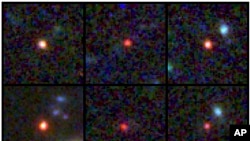Astronomers have discovered what appear to be huge galaxies dating back to within 600 million years of the Big Bang. The findings suggest the early universe may have quickly produced these extremely large galaxies.
The new James Webb Space Telescope has seen even older galaxies, dating to within 300 million years of the beginning of the universe. But it is the size and maturity of these six galaxies that excite scientists.
Ivo Labbe of Australia’s Swinburne University of Technology was the lead researcher. He and his team expected to find little galaxies this close to the beginning of the universe — not these very large ones.
He said most galaxies at that time are still small and slowly grow over time. But, “there are a few monsters that fast-track to maturity. Why this is the case or how this would work is unknown.”
Each of the six objects looks to weigh billions of times more than our sun. In one of them, the total weight of all its stars may be as much as 100 billion times greater than our sun, the scientists found. They recently published their findings in the journal Nature.
Yet these galaxies are believed to be very compact. They have as many stars as our own Milky Way, but in a relatively small area in space, Labbe said.
Labbe said he and his team did not think the results were real at first. They thought there could not be galaxies as mature as the Milky Way so early in time. The objects appeared so big and bright that some members of the team thought they had made a mistake.
Pennsylvania State University’s Joel Leja, who took part in the study, calls them “universe breakers.”
The finding that “massive galaxy formation began extremely early in the history of the universe upends what many of us had thought was settled science,” Leja said in a statement. “It turns out we found something so unexpected it actually creates problems for science. It calls the whole picture of early galaxy formation into question.”
These galaxy observations were among the first data that came from the $10 billion Webb telescope. The telescope, from NASA and the European Space Agency, was launched just over a year ago to replace the Hubble Space Telescope. Hubble is approaching its 33rd year of service.
Webb is bigger and more powerful than Hubble. It can see through clouds of dust with its infrared vision and discover galaxies previously unseen. Scientists hope to eventually observe the first stars and galaxies formed following the creation of the universe 13.8 billion years ago.
The researchers still are awaiting official confirmation of their research. They are careful to call them candidates for now. Leja said it is possible that a few of the objects might not be galaxies, but very large black holes.
While some may prove to be smaller, Labbe said at least some of them will likely turn out to be huge galaxies. “The next year will tell us,” he said.
One early lesson from Webb is "to let go of your expectations and be ready to be surprised,” Labbe added.
I’m Dan Novak.
Dan Novak adapted it for VOA Learning English based on reporting from The Associated Press.
_______________________________________________________________________
Words in This Story
mature — adj. reached a final or desired state
monster— n. something that is extremely or unusually large
fast track — n. a process or way of proceeding that produces a desired result quickly
compact — adj. smaller than other things of the same kind
massive — adj. very large and heavy
upend — v. to cause to be upside down
infrared — adj. producing or using rays of light that cannot be seen and that are longer than rays that produce red light










Forum